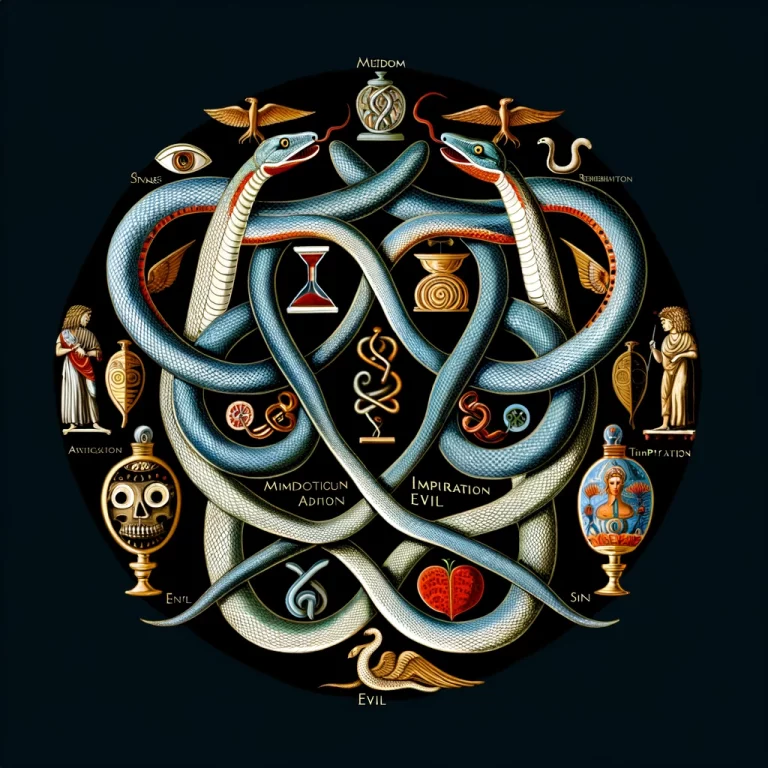Slithering Through Symbolism: What Do Serpents Represent?
Serpents, with their mesmerizing movements and enigmatic nature, have captivated humanity for millennia. Cultures across the globe and throughout history have woven these creatures into their myths, beliefs, and art, ascribing to them a rich tapestry of symbolic meanings.
One of the most intriguing aspects of serpent symbolism is its inherent duality. Serpents often embody seemingly opposite concepts, reflecting the complexities of the natural world and the human experience. This duality is evident in how serpents can represent both:
- Good vs. Evil: In the Bible, the serpent is the cunning trickster in the Garden of Eden, yet ancient Greek mythology reveres Asclepius, the god of healing, who is always depicted with a serpent entwined around his staff.
- Danger vs. Healing: While snake venom can be deadly, it has also been used for centuries in traditional medicine, highlighting their paradoxical nature.
Serpent Symbolism Across Cultures
Exploring how different cultures view serpents reveals the breadth and depth of their symbolic resonance:
- Ancient Egypt: Serpents were powerful symbols of protection and royalty. The cobra goddess Wadjet, often depicted coiled around the pharaoh’s crown, embodied divine authority and defense.
- Hinduism: Serpents represent spiritual energy, particularly the kundalini energy that lies dormant at the base of the spine. The serpent god Naga is associated with wisdom, eternity, and the mysteries of the underworld.
- Native American Cultures: The Hopi Snake Dance, a sacred ceremony, honors serpents’ connection to the earth, rain, fertility, and transformation.
Common Themes in Serpent Symbolism
Despite cultural variations, several core themes emerge when unraveling the symbolism of serpents:
- Transformation and Rebirth: The act of shedding skin, a process of renewal and rebirth, is central to serpent symbolism. The Ouroboros, a serpent or dragon eating its own tail, embodies the eternal cycle of life, death, and regeneration.
- Healing and Medicine: Asclepius, the Greek god of healing, is just one example of how serpents have been associated with medicine and the restoration of health. This likely stems from the use of snake venom in traditional healing practices.
- Fertility and Creation: The serpent’s shape and movements have long been linked to life force and procreation. Their sinuous forms evoke the generative energies of nature and the cycle of birth and renewal.
- Wisdom and Knowledge: Serpents are often depicted as guardians of secret knowledge or possessors of ancient wisdom. Think of the serpent in the Garden of Eden, who, despite its negative connotations, tempts Eve with the promise of knowledge.
- Guardianship and Protection: With their ability to defend themselves, serpents have become symbols of guardianship and protection, often guarding sacred spaces or treasures in mythology.
The Serpent’s Enduring Presence
Serpent symbolism has not lost its potency in the modern world. We encounter serpents in art, literature, film, and even our dreams, where they often represent challenges, transformations, or hidden aspects of ourselves. Snakes continue to fascinate and frighten us, reminding us of the duality within and the ever-evolving tapestry of meaning we ascribe to the natural world.
Outperforming Your Competitors: What Does the Serpent Represent Biblically?
The serpent holds a particularly intriguing and complex role in the Bible, embodying both alluring temptation and profound spiritual symbolism. To understand the serpent’s biblical significance, we must move beyond simplistic interpretations and explore the nuances of its portrayal.
The Serpent’s Dualistic Symbolism:
- Evil & Temptation: In the Garden of Eden (Genesis), the serpent embodies deception, cunning, and disobedience. Its temptation of Eve leads to the Fall of Man and cements its association with sin and spiritual downfall. This theme continues in Revelation, where the serpent is explicitly linked to Satan, the ultimate embodiment of evil.
- Wisdom & Cunning: Intriguingly, the Bible also acknowledges the serpent’s intelligence. In Matthew 10:16, Jesus advises his disciples to be “shrewd as snakes” when navigating a dangerous world. This suggests that even within the serpent’s negative traits, there are valuable lessons about wisdom, adaptability, and self-preservation.
Transformation & Rebirth:
- The serpent’s ability to shed its skin, undergoing a literal metamorphosis, holds potent spiritual meaning in Christianity. It serves as a powerful metaphor for spiritual transformation and rebirth through faith. This symbolism is evident in Numbers 21:4-9, where Moses crafts a bronze serpent that heals the Israelites from venomous snakebites. This act foreshadows Christ’s sacrifice on the cross, offering healing and salvation to those who believe.
Serpents in Biblical Dreams & Prophecy:
- Dreams: In a Christian context, serpent dreams often evoke spiritual struggle, the presence of temptation, or the need for discernment. They can serve as a call to prayer, vigilance, and reliance on God’s protection.
- Prophecy: The serpent’s association with Satan links it to biblical prophecies about the end times and the ultimate battle between good and evil.
Unlocking Deeper Meaning:
To truly understand the serpent in the Bible requires going beyond surface-level interpretations. Consider these avenues for exploration:
- Cultural Context: Examining how ancient cultures viewed serpents can shed light on the biblical authors’ use of this symbolism.
- Artistic Representations: Analyze how religious art has depicted the serpent throughout history, noting how its portrayal has evolved and what this reveals about changing interpretations.
- Addressing Misconceptions: Challenge common misunderstandings, such as the belief that the serpent in Genesis was literally Satan, to foster a more nuanced understanding.
- Practical Application: Discuss how recognizing the serpent’s symbolism can guide Christians today. This could include practical advice on resisting temptation, embracing spiritual growth, or discerning truth from falsehood.
Analyzing the Competition & Unleashing the Serpent’s Wisdom: Spiritual Meanings
Moving beyond the biblical context, exploring the spiritual meaning of snakes across cultures reveals a rich tapestry of interpretations. To create an article that stands out, consider these insights:
The Serpent’s Multifaceted Symbolism:
- Duality: Embrace the serpent’s representation of both positive and negative aspects of life: healing and poison, wisdom and temptation, rebirth and death.
- Cultural Significance: Highlight the diverse meanings of snakes in various cultures and religions:
- Ancient Egypt: Cobras as symbols of protection and royalty.
- Norse Mythology: Jörmungandr, the World Serpent, embodies chaos and the cyclical nature of time.
- Hinduism: Shesha, the multi-headed serpent, supports Vishnu and represents cosmic energy.
- Psychological Interpretation: Delve into the realm of dreams, where snakes often reflect repressed emotions, fears, or the potential for healing and transformation.
Core Spiritual Meanings:
- Transformation and Rebirth: Expand on the potent image of the snake shedding its skin, emphasizing its connection to personal growth, letting go of the past, and embracing renewal.
- Healing: Connect the snake to ancient healing practices and the restoration of balance. Mention the Rod of Asclepius, a snake-entwined staff from Greek mythology, as a lasting symbol of medicine.
- Wisdom and Intuition: Explore the association between snakes and intuitive knowledge. Their ability to navigate hidden places and their connection to ancient wisdom make them potent symbols of inner guidance.
The Snake as a Spirit Animal:
- Calling Upon the Snake: Discuss what it means to resonate with snakes as spirit animals. People drawn to snakes may be seeking transformation, healing, or a deeper connection to the mysteries of life.
- Gifts of the Snake: Explore the potential strengths of those who identify with snakes, such as strong intuition, a deep connection to nature, and the ability to navigate change with resilience.
Snakes in Dreams:
- Context is Key: Emphasize that dream interpretation is personal, and the meaning of a snake will vary depending on the individual’s experiences and the dream’s specifics.
- Potential Interpretations: Offer a range of possibilities, such as fear or threat (symbolizing unresolved issues), transformation (representing personal growth), or hidden knowledge (urging the dreamer to access their intuition).
Unlocking Unique Insights:
- Exploring the Shadow Side: Go beyond the positive interpretations of snakes to explore their darker aspects: fear, temptation, and the unknown. This adds nuance and depth.
- The Serpent and Feminine Energy: Highlight the connection between snakes and feminine power, creation, and the cyclical nature of life and death.
- Modern Applications of Snake Symbolism: Discuss how the spiritual meaning of snakes manifests in modern society, exploring its relevance to psychology, art, and even environmentalism.
Unveiling the Divine: What God Does a Snake Symbolize?
Snakes slither through the annals of mythology, often entwined with the divine. Their symbolism, however, is rarely straightforward. They can represent benevolent deities, fearsome creatures of chaos, or embodiments of dualistic forces.
The Serpent in the Divine Tapestry:
- Ancient Egypt: In this rich mythological landscape, snakes feature prominently. Wadjet, a cobra goddess, is a fierce protector of pharaohs and a symbol of royal authority. However, the serpent Apophis embodies chaos and threatens the sun god Ra, highlighting the serpent’s capacity for both protection and destruction.
- Ancient Greece: Asclepius, the god of healing and medicine, is rarely depicted without his serpent-entwined staff, known as the Rod of Asclepius. This image has become a lasting symbol of medicine and the restorative power of nature.
- Hinduism: The serpent god Naga is a powerful deity associated with wisdom, eternity, and the protection of sacred spaces. Shesha, another multi-headed serpent, supports the god Vishnu and represents cosmic energy and balance.
- Norse Mythology: Jörmungandr, the World Serpent, is a colossal creature that encircles the world. It embodies the chaotic forces of nature and the inevitable cycle of destruction and rebirth.
Beyond Specific Deities:
- Fertility & Life: The serpent’s association with the earth, its ability to shed skin, and its sinuous form have led to its connection with fertility, creation, and the cyclical nature of life and death.
- Guardianship & Protection: In many cultures, snakes are seen as guardians of sacred places, treasures, or secret knowledge. Their ability to defend themselves and their association with hidden places make them potent protectors.
- Wisdom & Knowledge: Often portrayed as creatures of ancient wisdom, snakes tempt and enlighten, embodying the pursuit of knowledge and the potential consequences of forbidden understanding.
Navigating the Serpent’s Duality:
- Embrace the Paradox: Acknowledge that snakes defy easy categorization. They can represent both the divine and the dangerous, the healing and the harmful.
- Cultural Context is Key: Highlight that the specific god or goddess associated with a serpent varies greatly across cultures and belief systems. Provide specific examples to illustrate this diversity.
Unlocking Deeper Meaning:
- Explore the Serpent’s Gender Fluidity: Discuss how snakes often transcend traditional gender roles in mythology, appearing as both male and female deities or embodying a more androgynous nature.
- Analyze Modern Depictions: Examine how the serpent’s connection to the divine is portrayed in contemporary art, literature, and film. Has its symbolism evolved, or does it still resonate with ancient beliefs?
Uncoiling the Serpent: A Deep Dive into Snake Symbolism in Psychology
Snakes, with their ability to evoke both primal fear and fascination, hold a prominent place in the human psyche. Exploring this symbolism through a psychological lens reveals much about our deepest fears, desires, and the transformative potential within.
The Jungian Perspective:
- Carl Jung, the influential Swiss psychiatrist, considered the snake a powerful archetype residing in the collective unconscious, a shared reservoir of human experience and symbolism.
- The Unconscious Mind: Snakes, for Jung, represented the unconscious itself – a realm teeming with primal instincts, hidden wisdom, and transformative potential. Their appearance in dreams often signifies a need to integrate these unconscious forces into conscious awareness.
- Individuation: The process of individuation, a key concept in Jungian psychology, involves integrating the conscious and unconscious aspects of the self to achieve wholeness. Snakes, through their shedding of skin and symbolic rebirth, represent this ongoing journey of self-discovery.
- Shadow Work: Jung believed we all possess a “shadow self” – those aspects of our personality that we repress or deny. Snakes, often associated with darkness and fear, can represent these shadow elements that we must confront and integrate for psychological health.
Duality of Symbolism:
- Danger & Fear: The snake’s venomous nature, predatory instincts, and association with poison naturally evoke fear and anxiety. This primal fear is often rooted in our evolutionary history and serves as a survival mechanism.
- Healing & Transformation: Paradoxically, snakes also represent healing and transformation. Their ability to shed their skin, emerging renewed, resonates with psychological processes of letting go, embracing change, and healing from past wounds.
Cultural & Historical Context:
- Ancient Judeo-Christian Beliefs: Explore the complex and often contradictory meanings of snakes in the Bible. They are linked to temptation and sin but also healing and divine power.
- Greek Mythology: Highlight the association between snakes, healing, and medicine through the figure of Asclepius, further emphasizing the dualistic nature of snake symbolism.
- Indigenous Cultures: Discuss the significance of snakes in various indigenous belief systems, where they often represent powerful spirits, ancestors, or guardians of sacred knowledge.
Snakes in Dreams:
- A Direct Line to the Unconscious: Dreams provide a window into the unconscious mind, and snakes frequently appear as potent symbols within this realm.
- Interpreting the Context: Emphasize that the meaning of a snake dream depends on the individual’s personal associations, the specific details of the dream, and the emotions it evokes.
- Common Interpretations:
- Fear or threat: The snake might represent a perceived danger, a challenging situation, or repressed emotions that need to be addressed.
- Transformation or healing: The shedding of skin could signify a period of personal growth, change, or recovery from a difficult experience.
- Hidden wisdom or intuition: The snake might act as a messenger from the unconscious, urging the dreamer to pay attention to their intuition or seek deeper self-knowledge.
Unique Insights & Untapped Potential:
- Exploring the Gendered Nature of Snake Symbolism: Delve into the historical and cultural associations between snakes and feminine energy, archetypes, and goddesses. How do these interpretations relate to modern psychology and gender roles?
- Snakes in Modern Psychotherapy: Research and discuss how therapists and counselors utilize snake symbolism in their practice, particularly in approaches like Jungian analysis or dream work.
- The Impact of Cultural Background: Examine how different cultures interpret snake symbolism in a psychological context. Are there universal interpretations, or do cultural beliefs significantly shape our understanding of snakes?
By weaving together these insights—Jungian psychology, cultural context, dream interpretation, and the potential for shadow work—you can craft a compelling and insightful article that explores the depths of snake symbolism in psychology.
Weaving Your Narrative: Internal Links and Cohesive Flow
Remember to seamlessly integrate the provided internal links into your article in a way that feels natural and enhances the reader’s experience. Here are some suggestions:
- When discussing serpent symbolism in mythology, link to the article on Minerva Mirabal. This connection could highlight how serpents are often associated with powerful female figures throughout history.
- When exploring serpent symbolism in storytelling and folklore, consider linking to the article on Grimm Fairy Tales by Trimble. This connection could lead readers to explore how serpents are often portrayed in classic tales and the lessons they convey.
- When discussing snakes as symbols of transformation and social change, link to the article featuring quotes by Dolores Huerta. This connection could create a powerful juxtaposition between a modern advocate for social justice and the ancient symbolism of the serpent.
- When exploring serpents in religious contexts and rituals, link to the article about the Hanukkiah. This connection could prompt readers to consider the symbolic significance of light overcoming darkness, which can be related to the serpent’s shedding of skin and themes of renewal.
Remember, these are just suggestions. The key is to incorporate the links organically, ensuring they add value to your article and enhance the reader’s understanding of the topic.
- Unlock Water’s Symbolism: A Cross-Cultural Exploration - April 20, 2025
- Identify Black and White Snakes: Venomous or Harmless? - April 20, 2025
- Unlocking Potential: Origins High School’s NYC Story - April 20, 2025















